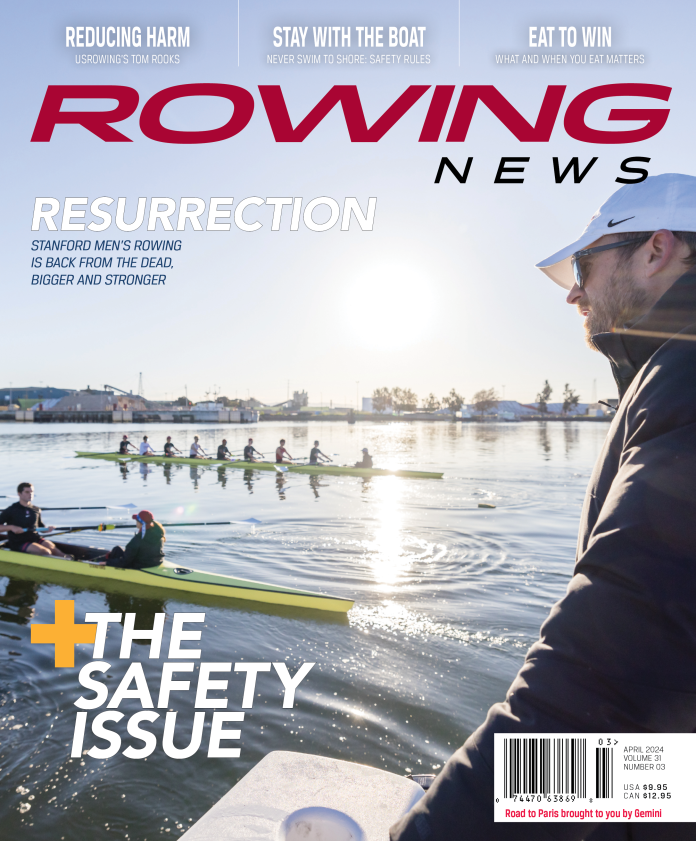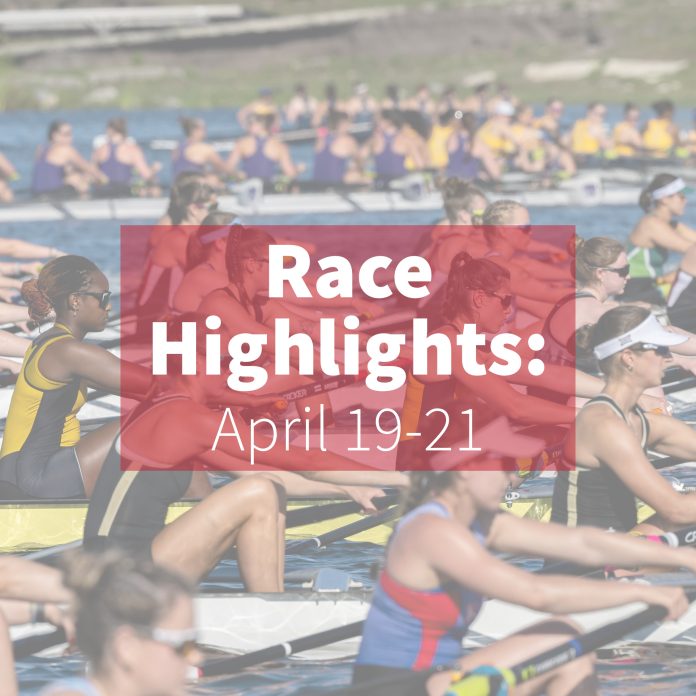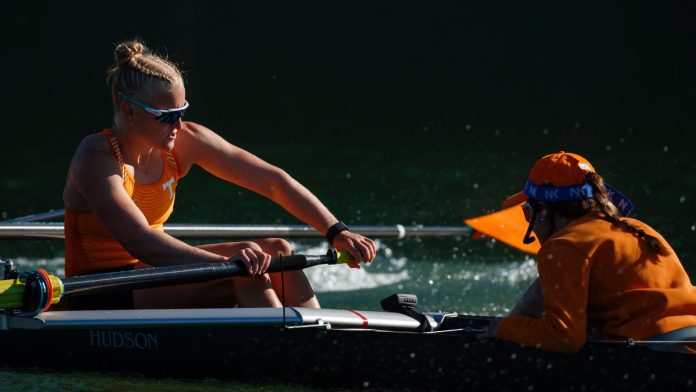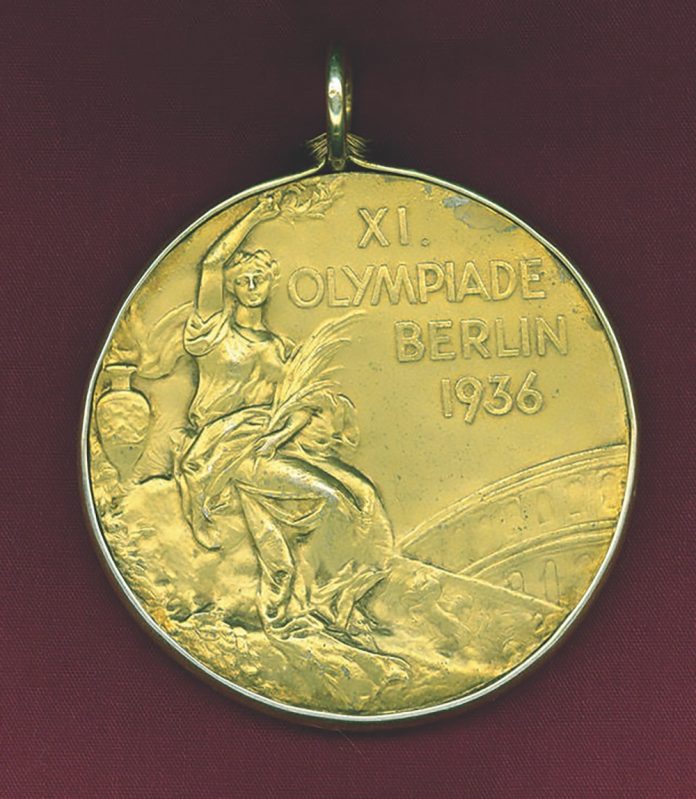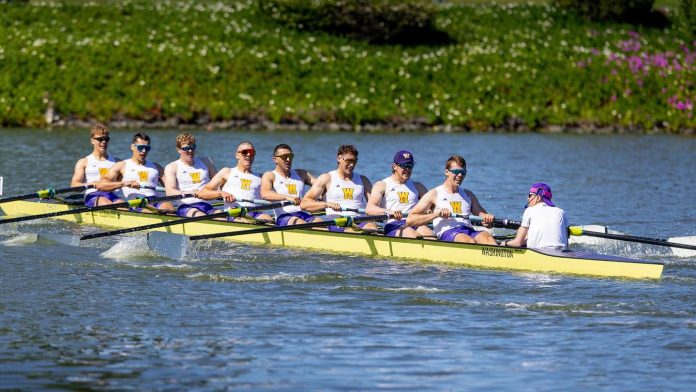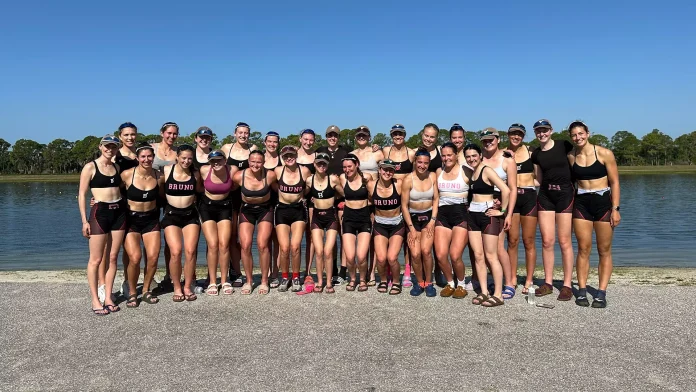Deerfield’s Winning Trifecta
In 2023, Deerfield Academy was the best rowing high school in America, with both the boys and girls varsity eights the top scholastic (non-club) finishers at the 2023 USRowing Youth National Championships (sixth and seventh, respectively, in the A final).
It was the first year student-athletes at the prestigious 227-year old school raced in eights instead of fours, and while success came immediately for Deerfield—both the girls and boys crews won the New England Interscholastic Rowing Association (NEIRA) varsity-eight championships and went on to race at Henley Royal Regatta—success did not come overnight.
It was years in the making, the result of a confluence of the three things behind every top rowing program: great athletes, great coaches, and great support.
Great Athletes
Coach Spencer Washburn downplays his role in the dominant year his boys crews had in 2023.
“We had the right group in place to make the switch.”
A measure of the fierce competitiveness of New England prep-school rowing is the fact that this spring Deerfield has been beaten across the line already by Salisbury School and Philips Academy (Andover), where Spencer and Deerfield’s girls coach Parker Washburn grew up and where their brother, Taylor, is the boys coach.
Their father, Peter Washburn, coached them at Andover, rowed at Syracuse with his two brothers, and also grew up at an elite boarding school—Delaware’s St. Andrew’s School—where his father, Davis Washburn, taught and coached rowing for 40 years.
“The strength of the team begins and ends with the students who choose to participate,” said Parker, giving credit for Deerfield’s historic 2023 season first and foremost to the athletes.
“We had some great leadership. The kids were exceptionally patient and when they had their opportunities they made the most of them.”
As a highly selective boarding school with a strong academic tradition dating to its founding in 1797, Deerfield Academy attracts high-achieving students exclusively. With an endowment of $791 million, the school is able to cover 100 percent of the financial need of everyone admitted.
“We’re rowing, but more broadly, the kids are looking to strive for excellence in all areas of school life,” Spencer said.
In recent years, an increasing number of incoming students are arriving at the western Massachusetts school on the Connecticut River with rowing experience—and high expectations.
“The first year I was here, maybe there were one or two kids who had done any rowing. And now there’s a pretty significant number,” Spencer said. “It injects a level of energy and experience into the program from day one. That’s been fun to see. It’s really different from 10 years ago.”
Great Coaches
Deerfield offered club rowing 40 years ago and got serious about varsity rowing with the hiring of accomplished coaches, including but not limited to the Washburns.
“Ten years ago when I got here, I had 28 boys on the roster,” Spencer said. “Last spring, I had 57.”
That kind of growth is great for the depth and impact of a rowing program on a student body, but the experience of athletes suffers if opportunities to race can’t be found for nine boats of rowers and coxswains in coxed fours.
“It got to the point over the past couple of springs where running a fours program with that many kids was a real challenge,” said Spencer.
Parker faced the same challenges with the girls the year before the switch to eights.
“The team was growing. There were 39 girls who wanted to row that year, and getting them on the water consistently and finding great opportunities for them against other fours programs was challenging.
“Certainly there was a lot of success in that season. But it didn’t feel great,” said Parker, that the girls starting out were having a different experience and opportunities to race than the more seasoned girls.
“Last year, we had 46 girls on the team. Providing a positive experience for everybody was challenging as well. We have great kids here. The students are committed to the team, committed to the sport, and committed to their development in a way that makes me feel fortunate.”
Deerfield Academy had a successful history as a fours program, including winning recent NEIRA and Youth National championships.
“I came to interview 11 years ago,” recalled Spencer. “The then head of school, Margarita Curtis, closed our conversation by saying, ‘I want to be the best high-school program in the country.’ That’s what I walked away with from the conversation: They’re invested in making this not just really good, which is what it was, but even better.
“I like to dig into my dad’s memories about what he had to do [as a boarding-school coach in the past], like drive the bus. We certainly get support in a way he never had.”
Spencer and his wife recruited Parker and his wife from another New England prep school. In addition to coaching rowing together, Spencer’s wife, Megan, and Parker’s wife, Liz, also teach in the science department together.
“As we got to know the school more, our professional priorities aligned really well,” Parker said. “I felt like there was going to be a lot of growth in my own teaching by moving here.
“In talking with Bob Howe, the athletic director, he had high aspirations for the girls team. There was growth happening on the girls side, but perhaps not to the same extent” as the boys, who won their last USRowing Youth National Championship in the coxed four in 2022, before switching to eights.
“It’s been fun,” said Spencer, “from both a working and family standpoint to have them on campus. I’ve got three boys and they’ve got little girls, and my boys love the fact that they have cousins who live right across campus.”
Great Support
When boys coach Spencer Washburn presented the proposal for the New England boarding school to switch to eights, there was good reason, considering the expense and likely headaches, to expect pushback from the administration. Instead, he found support.
The Deerfield CFO’s first question, Spencer recalled: “Is this what’s best for the students?”
“I laid out my thoughts and what we might want to do to get there, and they’ve done it.”
Deerfield is one of a few high schools to have moving-water indoor rowing tanks, part of a new athletic complex that includes an ice hockey rink, indoor track, and turf field.
“They went through and asked all the coaches, ‘What do you want? You guys want an erg room, right?’ I said, ‘No, we can put ergs anywhere,’” Spencer said. What the rowing program wanted, and got, were tanks.
“It just pops as a facility to walk through that place. We’ve got kids in there taking their first strokes to kids who are heading off to college, and it’s useful to all of them. It’s been a great piece of equipment to have at our disposal.”
Deerfield goes to Florida to train in the second week of its two-week spring break, which gets the New England school on the water—something the weather kept them from doing every day when they got back this year.
Deerfield also benefits from extraordinary support from parents.
“Every year, we have a group of parents who ask, ‘How can we support this program? How can we support the experience of our students?’” said Spencer. Despite having the children of Olympians and other accomplished rowing parents on the team, the Deerfield coaches haven’t experienced the kind of meddling common in youth sports today.
“The parents have been exceptionally supportive, not just of the team, but of their children in terms of having a good perspective on what’s important,” Parker said.
Even though Deerfield is a prep school, as in preparing students for college, Parker says there’s no emphasis on college recruitment.
“If they’re interested in rowing in college, I’m happy for them to engage in the recruitment process. But what I tell the students is, I’m here to support them, but it’s their process to own. Conversations are about what schools—not necessarily what rowing programs—but what schools are you most interested in.”
Having successfully transitioned to eights rowing in the spring, is sculling in the fall next for Deerfield?
“That’s actually a conversation that I’ve begun with our director,” said Spencer. “We don’t want kids rowing from September to June. We feel great about the fact that our kids are not rowing year-round, that they are involved meaningfully in other things on campus, whether it be other sports or theater or student government.
“But we also look at the rowing landscape, and sculling and small-boat rowing are becoming an important part of both preparation for college and becoming a better, more complete rower.”
For Parker Washburn, who rowed at Andover, Harvard, and Craftbury’s Green Racing Project, Deerfield is proving to be a complete place already.
“I’ve been fortunate to have the opportunity to row under some great coaches and with some great teammates. I feel like this is another one of those places where we strive for excellence not only in rowing but in everything really.”
Race Highlights: April 19-21
Compton Cup: The #4 Princeton heavyweight men held on to the Compton Cup for the second year in a row, defeating #1 Harvard in the varsity eight by just 1.6 second and coming away with wins in the second and fourth eights as well. This is only the fourth time in the history of the dual race that Princeton has won consecutive races against the Crimson in the varsity eight (1933-36, 1956-57, 2015-16). This result, along with the racing from Redwood Shores, will be sure to cause a significant shake up at the top of the IRCA/ IRA Coaches Poll.
Big Ten Invitational: #5 Brown swept all 12 of their races at the Big Ten Invitational this weekend, taking on a deep field from across women’s rowing. In perhaps the most emphatic performance of the weekend, #15 Tennessee won 14 of 15 races with an average margin of victory of 9 seconds. The Lady Vols defeated at least one top-13 opponent in each of their 14 victories, coming away with wins over #9 Michigan, #12 Ohio State, #13 Rutgers, and #14 Duke. Full results here and full video replay here.
Tennessee Rowing has arrived as a national contender! Hard work on the Tennessee River pays off. Congrats ladies! #EverythingSchool #GBO 🍊 https://t.co/sNiJam6W47
— Danny White (@AD_DannyWhite) April 20, 2024
Cal/UW Dual: Cal and Washington split the day of racing at Redwood Shores with the Cal women sweeping all races and the Washington men winning all of their races, save the freshmen eight. The Husky men handed the Cal varsity eight their first loss since 2021, during which time the Golden Bears have won two IRA National Championships. The Cal women will return home with the Simpson Cup for the first time since 2019. “Washington brought out the best in us today,” Cal head coach Al Acosta said after racing. Full results here.
The women's V8+ race is underway!
📺 https://t.co/OpLVsZ1fzr
⏱️ https://t.co/auLPobh2RT#RowingU x #TheBoysInTheBoat x #WomenOfWashington pic.twitter.com/QKR67ub18t— Washington Rowing (@UW_Rowing) April 20, 2024
A Wild West Story, Well Told
Rowing is challenging. Racing even more so. Now try doing it on the Willamette River in Corvallis, Ore. There’s a fast current, seasonal flooding, narrow bridges, floating tree trunks and other debris, darkness, rain, and cold. And it was worse before the 1960s, when dams were built.
Karl Drlica, author of Bitten by the Rowing Bug: Challenges of an Untamed River, knows this intimately. For decades, his father was Oregon State University’s rowing coach, fighting the elements and fighting for funding. The latter challenge proved almost more daunting than the forces of nature. Drlica watched his father struggle to build a rowing program in Corvallis. Then he, too, became a rower and coach.
Going far beyond his personal recollections, Drlica–a microbiologist who has written several books on DNA–has done exhaustive research on the turbulent story of Oregon State rowing. He draws on numerous interviews and troves of original documents, including the diary of his coach-father (the proof is 62 pages of footnotes!). The result is a definitive history of one of the first rowing clubs of any West Coast university–a fascinating read filled with untold stories of creativity and grit.
A coach from the 1920s who preceded Drlica’s father foretold the equipment problems that would plague Corvallis rowing for decades. Without docks or floats, the men had to wade into the water to climb into their shells.
“The boats leaked plenty, and the men became quite proficient in estimating how far they could row down the river and still return without going ashore to dump out the boat, or even sinking on occasion. Neither did it matter that the old shed boathouse leaked like a sieve and that it had no floor, only a mud bank slanting so much that on wet days it was no small feat to get a shell either in or out…. There was no place to dress or leave clothing if one did change. If an oarsman got wet, he went home wet and liked it.”
An intrepid coach during the 1930s commandeered an abandoned electric-railroad depot and turned it into a boathouse. Unable to afford boats, the oarsmen began building their own, using plywood and newly developed waterproof glue—a process, Drlica says, later used by the U.S. Navy to build PT boats in World War II.
Bringing ingenuity and perseverance to the orphan rowing club, Drlica’s father in the 1960s cajoled the U.S. Navy into donating two surplus ammunition barges otherwise headed for mothballing to use as boathouses. He fought endlessly and often futilely for funding, which rowers supplemented by staging jog-a-thons, painting house numbers on driveways, and cleaning football stadiums.
His father saw rowing as character-building and had long encouraged intramural rowing in the hope that its popularity would win university support. But in the 1960s, when his budget was whacked in half after years of stagnation, he had to cut intramural rowing to focus on the men’s heavyweight team and a burgeoning intercollegiate women’s crew.
Drlica’s book broadens from the nitty-gritty issues unique to the Willamette River and Oregon State to a larger national picture through his chapters devoted to the struggles of women’s rowing. That story is told largely through Astrid Hancock, who coached at Oregon State after teaching rowing at all-female Wellesley College near Boston.
In the late 1800s, Hancock tells Drlica, “Wellesley crew was more about singing than rowing.” The crews would row in full-length skirts, and rowing was touted as producing “an erect carriage, finely poised head, full chest, well-placed shoulders, strength of back and chest, and deep breathing.”
By the time she left in 1963, Wellesley women had become competitive and were fighting for a new boathouse. At Oregon State, she brought her crew to the first regatta of the newly formed National Women’s Rowing Association in Seattle, where they slept on the floor.
“Nobody had any money,” she said. Oregon State was one of seven teams in that landmark 1966 regatta, all from the West Coast except the Philadelphia Girls Rowing Club. The Oregon State oarswomen, like the men, faced money shortfalls, and it was only in 1969 that they raised enough to replace their heavy men’s crew shells with smaller, lighter women’s boats.
Women’s rowing was exploding around the country. Title IX, which took effect in 1973 and required equity in funding for men and women in federally supported schools, was no panacea for women’s crew at Oregon State immediately. When the women, whose locker room was the decrepit electric-railroad depot, asked for showers on a par with those of the men, the administration sent plumbers in to shut off the men’s showers so they’d be as second-rate as the women’s.
Through memos written by university officials in the 1970s, Drlica exposes an effort to kill the rowing program his father had built. Writing to the college president, the head of physical education wrote: “I would suggest that we consider carefully whether or not Oregon State University wishes to continue the crew activities.”
After the student newspaper reported that crew was being killed, an outpouring in the press, an undergraduate row to the state capital, and protests from alumni reversed the call, though the survival of rowing teetered for another three years.
Eventually, both men and women’s crew won varsity status at Oregon State and continued to succeed in national competition, but for Drlica’s father, who for 30 years had championed Corvallis rowing, the final days were bitter. Oarsmen were complaining in newspaper stories that his coaching was out of step with the times, that he didn’t listen to his athletes, that his program had grown too big for him to handle.
In his 1980 resignation speech, Drlica said, “The straw that broke the camel’s back, so far as I’m concerned, was when [the Athletic Board] hired a women’s volleyball coach on a full-time basis, while at the same time the men’s coaches are working on a part-time basis and teaching other classes in physical education….I anticipate that [continuing would] be like hitting my thumb with a hammer because it’s going to feel so good when I stop.”
Despite the difficulties and dangers that Karl Drlica presents in his book about the Willamette River and Corvalis rowing, the greatest danger the author faced happened to himself when, as an aging masters rower, he experienced the most frightening of possibilities on the river: his own heart attack. He describes what happened in the epilogue with the same intense detail that imbues his recounting of Oregon State rowing.
Drlica collapsed sideways in his boat, which rolled over, leaving him upside down, his feet stuck in the foot stretchers, his head underwater. He would remain unconscious as he was pulled from the water, given three shocks with a defibrillator on the dock by a physician-rower, and raced to the hospital, where he woke up three days later.
To piece together the story, Drlica did the kind of definitive reporting that characterizes his entire book: He interviewed everyone who helped save him. Dotty Brown
#15 Lady Vols Win Five Races Saturday to Cap Dominant Weekend at Big Ten Invitational
SARASOTA, Fla. – Wrapping up action at the Big Ten Invitational in extraordinary fashion Saturday was the 15th-ranked Tennessee rowing team, earning five wins in as many races to place an emphatic exclamation point on a stellar weekend.
Overall, Tennessee won 14 of the 15 races in which it had a boat competing in during the two-day event at Nathan Benderson Park.
Tennessee’s average margin of victory in each of its 14 wins in Sarasota was a whopping 9.031 seconds.There was at least one top-13 opponent in each of those 14 race wins. Furthermore, there were at least two top-13 opposing boats in nine of UT’s 14 race wins.
In Saturday’s action, the Lady Vols faced off against three opposing crews per race, each of which were ranked inside the top 16 in the CRCA national poll.
Tennessee’s 1V8+ crew—Sasha Radovanovic (coxswain), Meg Flanagan, Emma Seawright, Sarah Abrams, Alex Pidgeon, Stella Mirkovic, Alice Fahey, Nicole Campbell and Gracie Condon—recorded a strong performance en route to crossing the line in 6:23.176 Saturday morning. No. 13 Rutgers was nearly five seconds back, 16th-ranked Indiana finished over six seconds behind the Lady Vols and the first varsity eight crew of No. 14 Duke was over eight seconds behind UT.
The Lady Vols’ second varsity eight boat—Elizabeth Walley (coxswain), Sophie Hill, Megan Hewison, Riley Ferdelman, Hannah Smith, Hannah Richardson, Paige Reymann, Katie Rice and Erin Gifford—put down the fastest time of any boat in competition Saturday, posting a final time of 6:20.650. That mark outpaced second-place Indiana’s 2V8+ boat by an eye-opening 15-plus seconds. Duke’s crew was over 17 seconds off of UT’s time, while Rutgers crossed the line over 20 seconds after Tennessee.
In the 1V4+ race, Tennessee (7:14.453) crossed the line nearly three seconds ahead of Duke, in what was the Lady Vols’ closest win of the day. Indiana was a distant 12-plus seconds behind the UT crew upon crossing the line.
Tennessee’s 2V4+ crew also handled its business Saturday, posting a convincing win and finishing in 7:19.229. That final time was nearly nine seconds ahead of Duke and 23-plus seconds ahead of fourth-place Indiana.
The 3V8+ race capped the successful event for Tennessee. It was another win for the Big Orange, as the crew crossed in 6:41.996, over six seconds ahead of Duke and a tick under 24 seconds ahead of fourth-place, 12th-ranked Ohio State.
Up next, Tennessee travels to Raleigh, North Carolina, for the Lake Wheeler Invitational, running Friday-Saturday, April 26-27.
Race Results
1V8+:
1. #15 Tennessee (6:23.176)
2. #13 Rutgers (6:28.126)
3. #16 Indiana (6:29.954)
4. #14 Duke (6:31.288)
2V8+:
1. #15 Tennessee (6:20.650)
2. #16 Indiana (6:35.830)
3. #14 Duke (6:37.881)
4. #13 Rutgers (6:40.743)
1V4+:
1. #15 Tennessee (7:14.453)
2. #14 Duke (7:17.402)
3. #13 Rutgers (7:21.762)
4. #16 Indiana (7:27.666)
2V4+:
1. #15 Tennessee (7:19.229)
2. #14 Duke (7:28.034)
3. #13 Rutgers (7:33.567)
4. #16 Indiana (7:42.808)
3V8+:
1. #15 Tennessee (6:41.996)
2. #14 Duke (6:48.597)
3. #9 Michigan (6:50.014)
4. #12 Ohio State (7:05.937)
Lineups
1V8+: Sasha Radovanovic (coxswain), Meg Flanagan, Emma Seawright, Sarah Abrams, Alex Pidgeon, Stella Mirkovic, Alice Fahey, Nicole Campbell, Gracie Condon
2V8+: Elizabeth Walley (coxswain), Sophie Hill, Megan Hewison, Riley Ferdelman, Hannah Smith, Hannah Richardson, Paige Reymann, Katie Rice, Erin Gifford
1V4+: Laila Irigoyen (coxswain), Channing Taner, Logan Yates, Casey Chronister, Maylie Valiquette
2V4+: Audrey Bast, Sheya Lavin, Allison Lea, Alyssa Biernat, Abby Fowler
3V8+: Mykayla Fluster (coxswain), Lili Binetti, Paris Thornburg, Beatrice Bernard, Natalia Loram, Tiara Dye, Maiya Birdling, Kiana Worobey, Evelyn Hedrick
What Price Glory?
An email brought to my attention the following notice: “1936 Berlin Olympic Gold Medal Won by ‘Boys in the Boat’ Rower John White to be Auctioned.” The sender attached the full news item and added, “My friend and I are saddened by this news.”
My first response was also to feel sad. Is the almighty buck the bottom line for everything? This news sat with me for a while as I decided what I wanted to say about it. By coincidence, at about the same time I received this, the internet reposted a story from five years ago. Kareem Abdul-Jabbar, one of the greatest basketball players of all time, had auctioned off four of his six NBA-championship rings and three of his six MVP trophies for $2.8 million in 2019.
Why was the King of the Skyhook doing so? He put the money into his Skyhook Foundation that “gives kids a better idea of where they can go with their education. It puts them on a path to becoming scientists, technicians, and engineers.
“Kids all want to become LeBron James or Jay-Z or Beyoncé, and they really don’t have realistic ideas about what they can do with their educational opportunities.
“When it comes to choosing between storing a championship ring or trophy in a room, or providing kids with an opportunity to change their lives, the choice is pretty simple,” Abdul-Jabbar said. “Sell it all.”
I felt better immediately about Abdul-Jabbar’s sale. What better reason for parting with a room full of trophies? It got me wondering about other sales of sports memorabilia. What were the motivations? This is the kind of thing for which the internet is superb. In no time at all, I had tracked down numerous cases of auctioned-off Olympic medals.
Mark Wells, who won a gold medal on the 1980 “Miracle on Ice” hockey team, sold his for $310,000 to pay for medical treatments related to a rare genetic disease that damaged his spinal cord.
Mark Pavelich, a member of the same hockey team, sold his for $263,000 so that his daughter could “get a step forward in life.”
Otylia Jedrzejczak of Poland sold her gold medal from Athens for winning the 200-meter butterfly for $80,000 to benefit a Polish charity that helps kids with leukemia.
“I don’t need the medal to remember,” she said. “I know I’m the Olympic champion. That’s in my heart.”
I don’t know much about Johnny White, who rowed in the four seat in the famous Husky Clipper. He was 20 years old when they won in Berlin. He graduated from the University of Washington with a degree in metallurgical engineering and later worked for Bethlehem Steel in sales, eventually becoming general manager of sales.
There’s not much about him in Daniel J. Brown’s best-seller, The Boys in the Boat. White died in 1997 before the book’s 2013 publication. After thinking of reaching out to the family to ask about him and what the medal meant to him, I decided that was not appropriate. It was his medal to do with what he wanted. I’ll do a lot for my readers but I’m not going to be judgmental or scolding. Who knows why the sale is important or necessary?
I think of my close friend Jim Chapin, who was the six man in Trinity College’s Ladies Plate-winning eight at the 1976 Henley Royal Regatta. After looking at his medal for a few months, he gave it to his coach, Norm Graf. I was shocked at first. Did it mean so little that he gave it away?
But Jim said because it was so meaningful he wanted to give it to the man who guided them through their season to victory.
“I have my memories, and Charlie Poole and I both have our names engraved on the trophy as captains. That’s good enough for me. I wanted Coach to have it; it was the culmination of a lifetime of coaching for him, and I wanted to thank him.”
The on-line auction will begin in May and continue until June 9, the Gray Flannel Auctions representative told me. The opening bid is $10,000. Have they auctioned off other rowing gold medals? Their rep pointed me to basketball and swimming medals that have sold from $60,000 to $250,000–but none for rowing. The upper end seems to be Bob Beamon’s historic world-record 29.2 feet in the long jump at the 1968 Mexico Games. It went for $440,000.
It would be nice if some tech billionaire bought White’s medal and donated it to the George Pocock Rowing Foundation in Seattle, where it could be seen by scores of people. An artifact like this is inspirational.
Johnny White didn’t win his medal for me or for us. He won it for himself and for the other eight guys in the boat. If his heirs want to sell it, who are we to say we know better?
Husky Men Win Schoch Cup At 112th UW-Cal Dual
REDWOOD CITY, Calif. – The Washington men’s rowing team earned the Schoch Cup with a win in the varsity eight and won four of five races overall Saturday at the 112th Washington-California Dual Regatta.
The Huskies’ top crew handed California its first loss since the 2021 IRA National Championships, which UW won, finishing the race with a course-record time of 5:24.0. The Golden Bears had been undefeated and won the national title the last two seasons.
“The level that Cal has been rowing the last few years made us evaluate what we were doing and made us get better,” said UW head coach Michael Callahan. “There was great effort across all of our boats. The team has been really committed this year and it showed on the race course today.”
With freshman coxswain Nikita Jacobs making his debut in the varsity shell, the Huskies came off the starting dock trailing the Bears in the early-going. Cal took as much as a four-seat lead in the first 500 meters, but UW did not let the defending champions get away.
In the second quarter of the race, the Huskies cut the lead and, as the crews passed the halfway mark, it was all even. The Huskies made their move just after 1,000 meters and held off the Bears the rest of the way. UW’s course-record time of 5:24.0 was 3.7 seconds and a bit of open water ahead of California (5:27.7).
The Huskies earned the Delos “Dutch” Schoch Cup for the 77th time in the 112 years of the Dual.
“The Dual is a tremendous annual tradition for both teams,” Callahan noted. “It’s a race that we are absolutely going to continue even though the two schools are headed to different conferences next season. Both UW and Cal are firmly committed to continuing this cherished event.”
The Huskies also won the second and third varsity eight, and the varsity four race; while California took home the freshman eights crown.
In the 2V8+ race, the Bears also had the early lead, but the Huskies caught the Bears in the third 500 and rowed to victory with a time of 5:30.5. Cal finished in 5:33.9, as both teams posted impressively fast times for a second eights race.
Washington’s third varsity eight crew, which has spent more time racing this season than any other group in the shell house, remained unbeaten. The UW’s third crew won its race with a time of 5:39.2, while Cal finished in 5:45.5.
The Huskies’ varsity four led its race for, essentially, all 2,000 meters and won the most decisive victory of the day on the men’s side. UW finished in 6:22.9, while Cal’s final time in the four was 6:34.7.
In the first men’s race of the morning, the Cal freshman eight earned a win, leading throughout the 2,000 meters. The Berkeley freshman won with a time of 5:42.9, while UW finished in 5:46.9.
Next up, in two weeks, is the annual Windermere Cup & Opening Day Regatta, when men’s and women’s crews from Italy and the University of Wisconsin will race the Huskies on Montlake Cut in one of the world’s great annual rowing events.
“We’re looking forward to getting back to Seattle and packing the Cut for Windermere Cup,” Callahan concluded.
WASHINGTON LINEUPS
Varsity Eight
Shell: Brett Reisinger ’98
Cox: Nikita Jacobs
Stroke: Max Heid
7: Archie Drummond
6: Jonathan Wang-Norderud
5: Giuseppe Bellomo
4: Sam Ford
3: Cameron Tasker
2: Harry Fitzpatrick
Bow: Marius Bjørn-Hansen Ahlsand
Second Varsity Eight
Shell: ShoedaWg
Cox: Kieran Joyce
Stroke: Darcy McCluskey
7: Ethan Blight
6: Marc Tennesen
5: Povilas Juskevicius
4: Ben Shortt
3: Lyle Donovan
2: Ryan Smith
Bow: Blake Vogel
Third Varsity Eight
Shell: John Nordstrom
Cox: Casey Neumann
Stroke: Gus Altucher
7: Blake Bradshaw
6: Quinn Hall
5: Parker Raines
4: Louis Gallia IV
3: Luke Henry
2: Ewan Morrow
Bow: Giulio Acernese
Varsity Four
Shell: Lou Gellermann ’58
Stroke: Connor Shoup
3: Finn Griskauskas
2.: Ryan Martin
Bow: Luke Collins
Cox: Maggie Gibbons
Freshman Eight
Shell: Grand Challenger
Cox: Chas Knittel
Stroke: Hector Guimet
7: Billy Osborne
6: Klas Ole Lass
5: Rory McDonnell
4: Matteo Belgeri
3: Carter Yagle
2: Ryan O’Connor
Bow: Dimitri Chamitoff
#5 Brown Women’s Rowing Caps Weekend Sweep of Big Ten Invite
SARASOTA, Fla. – The fifth-ranked Brown Bears closed out the B1G Invitational in style, picking up four victories on Saturday to sweep the two-day event. All four of Brown’s crews won three races as the Bears picked up 12 victories in 12 races.
“Another day of strong racing against excellent competition,” said head coach John Murphy. “This was truly a team effort as each boat faced challenges but each boat gave it their best effort. We will be back at it on Monday working on getting faster and looking forward to the races ahead.”
The B4 kicked off the morning with its third win in as many races with a time of 7:23.366 to edge out Michigan (7:27.598) and Ohio State (7:30.781).
The A4 also picked up its third win in as many races with a time of 7:10.367 for a nearly five-second victory over second-place Michigan (7:15.099).
The Bears held off a Buckeye charge in the final 500 meters to pick up a 2V8 victory with a time of 6:30.213. Brown crossed the line more than two seconds ahead of Ohio State (6:32.569) and almost 10 seconds ahead of Michigan (6:39.856).
The Bruno V8 jumped to an early lead and held a slight lead over both Michigan and Ohio State for the entire course, crossing the line in 6:23.006 to close out the victory over the Wolverines (6:24.693) and Buckeyes (6:45.602).
The Bears return to action next Saturday with a dual race against Cornell in Ithaca, New York.
Lineups and Results:
Varsity 8
Brown – 6:23.006
Michigan – 6:24.693
Ohio State – 6:27.112
SMU – 6:45.602
B – Ashley Giannetti
2 – Dahlia Levine
3 – Caroline Schmitz
4 – Bisbee Scott
5 – Emily Jaudon
6 – Mary Claire Warren
7 – Nadia Vondeling
S – Hannah Hickson
C – Kayden Obsitnik
Second Varsity 8
Brown – 6:30.213
Ohio State – 6:32.569
Michigan – 6:39.856
SMU – 7:00.090
B – Eliza Atwood
2 – Jessica McGrady
3 – Tessa Tomkinson
4 – Olivia Vavasour
5 – Riley Cooper
6 – Ava Rothmeyer
7 – Jessica Hooper
S – Isla Wilding
C – Molly Lundberg
A4
Brown – 7:10.367
Michigan – 7:15.099
Ohio State – 7:26.663
SMU – 7:39.347
B – Elizabeth Hedeman
2 – Matilda Damon
3 – Audrey Roche
S – Annie Herring
C – Summer Balla-Kellett
B4
Brown – 7:23.366
Michigan – 7:27.598
Ohio State – 7:30.781
B – Orla Fitzgerald
2 – Isabel Wilkowski
3 – Francesca (Kiki) Fraim
S – Ellie Knight
C – Caitlyn Roddy

